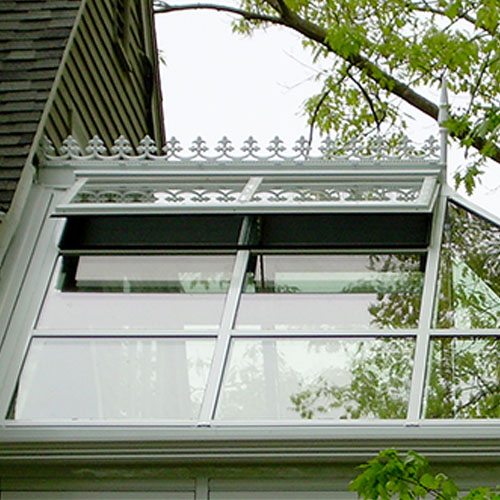Greenhouses 101
Welcome to the Solar Innovations® Greenhouses 101 tool. This comprehensive, interactive tool will assist you in the design of the greenhouse of your dreams. From the early planning stages of where to place the greenhouse on your property, all the way down to the decorative touches that will set your greenhouse apart, you will find everything that you are looking for. If you are looking to learn about a particular detail, just click any of the buttons above. Or, if you would like to know about multiple items, just check them off below and click SUBMIT. We have also included a handy checklist that you can fill out, so you are better prepared when it comes time to speak to one of our expert sales designers. And as always, feel free to download our Greenhouse Brochure.
DESIGN FOR YOUR CLIMATE
ZONE 1 – During winter, these states face extremely low temperatures and greatly reduced sunlight. Energy efficiency is paramount. Greenhouses should be designed with high-performance insulated glass that allows more light transmission and solar heat gain. In some circumstances, triple-pane glass is recommended. Larger-sized heaters and grow lights are needed for year-round growing.
ZONE 2 – These states experience moderate temperatures that may exceed both the high and low extremes of the plant growing range. Most greenhouses will require insulated glass, and need less light transmission and solar heat gain than in Zone 1. During the winter, heaters are required for plant survival, with some varieties requiring grow lights. In the summer, an evaporative cooler and/or shades may be needed.
ZONE 3 – High temperatures and extreme sunlight intensity are common in these states. Most greenhouses will require insulated glass, but some may be designed with monolithic (single pane) glass. Specialty glass may be incorporated in the roof of the greenhouse to reduce light transmission and solar heat gain, especially in the summer. Most greenhouses will require evaporative coolers and/or shades for the summer season. During the winter, heaters are required for most plant types.
ZONE 4 – Sunlight can be intense in these states. A specialty roof glass will reduce light transmission and solar heat gain throughout the year. Most greenhouses will require insulated glass, but some may be designed with monolithic (single pane) glass. This region can experience fluctuations between winter and summer so an evaporative cooler, heater and shades are recommended.

Note: These are general climate characteristics for regions of the U.S. This information is intended for initial greenhouse design. For best greenhouse performance, location specific data must be used.
PLACEMENT CONSIDERATIONS
The position of the greenhouse on your property is key to the success of how it will perform. Maintaining proper sunlight, taking advantage of trees and ease of access are all concerns that should be addressed before ground is broken.
Trees
There are pros and cons with having trees near a greenhouse. The most common concern is that falling trees or limbs will damage the structure. Solar Innovations® uses tempered and laminated glass to reduce damage in the event of an impact. Deciduous trees can be beneficial because their foliage provides shade during the summer and allows for solar heat gain when their leaves drop in the winter.

OVERALL AESTHETICS
Even though any two greenhouses may be made of the same materials and have the same functionality, the aesthetics can be drastically different, as illustrated by the English and Contemporary greenhouses.

English
An English greenhouse is the epitome of traditionaly classic appearance. They are highly ornate yet functional and add charm to a home or business. English greenhouses may include decorative elements such as dormers, ridge cresting, finials, grids, masonry base walls, or raised panels. Pilasters, historically-designed gutters and Palladian arches also enhance the structure’s traditional appearance on the exterior. Crown moulding, bar caps in various profile options and decorative castings bring the same character into the interior space.

Contemporary
Unlike their decorative counterparts, contemporary greenhouses consist of large glass areas, clean lines and a linear format. Mullions are used to allow for long projections. The greenhouse’s finish can enhance the modern appearance. Popular choices include white, black, and clear anodized, which is often used in industrial settings. Stainless steel cladding can be applied directly to the aluminum frame as well. The interior of the greenhouse achieves a modern flare through the use of flat rafters and commercial grade accessories.
PERFORMANCE
Thermally-Enhanced Structures
The energy efficiency of your greenhouse can be greatly enhanced through the use of high-performance glazing and thermally-broken aluminum framing.

Thermal Break
A thermal break separates the aluminum and minimizes conductivity of heat and cold from the outside to the inside while ensuring the structure’s interior remains comfortable all year long. Solar Innovations® offers two types of thermal break systems; Polyamide Strut and Pour and Debridge. In the first method, a polyamide strut is threaded into the cavity between two aluminum profiles and crimped into place. In the Pour and Debridge system, liquid polyurethane is poured into aluminum cavities that have been machined with an Azo-Brader, that allows for the polymer to mechanically lock in place. Both methods improve thermal efficiency by breaking the highly conductive properties of aluminum. Nonthermal aluminum frames should only be used for interior spaces or where thermal conductivity is not important.


Impact-Rated Structures
For coastal applications Solar Innovations® is proud to stake claim to the industry’s only hurricane impact-rated glazed structure with operable vents, windows and doors. Our products are not only tested through structural analysis software, but also physically tested in our in-house test lab. Build with the peace of mind that your greenhouse can withstand the harshest conditions.
Testing Results
SI5200 Lean-To Structure as manufactured by Solar Innovations®. NCTL-110-20222-1
Air Infiltration Test (ASTM E283):
- Pressure of 1.6 psf (75 Pa): 0.06 CFM/ft2 18 (L/min)/m2 infiltration.
- Pressure of 6.2 psf (300 Pa): 0.14 CFM/ft2 42 (L/min)/m2 infiltration.
Air Exfiltration Test (ASTM E283/ ASTM E547):
- Pressure of 1.6 psf (75 Pa): 0.05 CFM/ft2 15 (L/min)/m2 infiltration.
- Pressure of 6.2 psf (300 Pa): 0.11 CFM/ft2 33 (L/min)/m2 infiltration.
Water Penetration Test (ASTM E331):
- Water pressure of 15.0 psf (718 Pa) and 5.0 (gal/h)/m2 204 (L/h)/m2, no leakage.
Uniform Structural Load Test (ASTM E330):
- Positive Design Pressure: 65 psf (3112 Pa)
- Positive Design Pressure: 65 psf (3112 Pa)
Florida Product Approval: Impact FL Approval No. Pending

FOUNDATIONS
While Solar Innovations® does not provide the foundation, we do make recommendations based on the greenhouse’s use and structure type. Please consult your local code official for regulations.
Concrete Foundations
For greenhouses larger than 200 square feet, a concrete slab, continuous concrete footing, or a concrete block footing is required and should extend below the frost line. Concrete block footings should extend a minimum of six inches above grade. Embedding anchor bolts into concrete is the best way to tie down the structure. It is recommended that a waterproof compound be applied as a moisture barrier and surround the foundation with insulation panels.

FLOORING
Your greenhouse floor needs to be comfortable for the gardener, allow for drainage, and be sterile. A French drain can be used for drainage, but must be installed as the foundation is poured.

Concrete
Concrete can increase thermal mass storage and does not harbor mold or disease; however, it will require regular cleaning due to soil build up.

Tile
Tile is durable and easy to clean and offers many color and pattern options. Use slip resistant or textured tile to help prevent falls.

Pavers with gravel
Pavers are a great way to reduce costs and can be placed in footpaths for better footing while the gravel acts as a perfect drain for water.

Gravel
Gravel is the most economical choice and reduces the spread of mud and dust. However, the gravel may need to be replaced and weeds may sprout.
STRUCTURAL CONFIGURATIONS
Once you have decided upon the style of your greenhouse, it is helpful to determine the overall shape of your structure as you begin to design your greenhouse. There are six standard configurations but Solar Innovations® will work with you to design whatever structure your plan requires.

Straight Eave, Double Pitch
Double pitch is a classic shape for greenhouses and is the most common configuration for free-standing units. It provides a uniform space that is tallest at the ridge. As you determine the roof pitch, keep in mind the surrounding structures, as well as the fact that each plane of the roof can employ a different pitch.


Straight Eave, Lean-To
A straight eave, lean-to design is the most common configuration for greenhouses attached to another structure. They tend to require a smaller investment of materials when compared to a double pitch, but can provide the same interior area. This configuration is an excellent option if you only have a small amount of space, though it works just as well over large spans along a building. An advantage to this shape is the solid rear wall, which can act as thermal storage for solar heat and a suitable place for shelves.


Curved Eave, Double Pitch
Reminiscent of wooden greenhouses of the past, a curved eave, double pitch configuration, exhibits a classic look, especially when adorned with decorative elements, such as finials and ridge cresting. The curve in the wall can begin high on the rafter to allow for taller interior elements, or low on the rafter for a more traditional look.


Curved Eave, Lean-To
Curved eave, lean-to structures have eaves that are curved and can evoke two distinct styles depending on how they are configured. Curves that begin high on the rafter tend to exhibit a more contemporary aesthetic while curves low on the rafter allow for a more traditional look.


Bull Nose End
This roof design includes a double-pitch section that tapers into a nose. It is also known as a conservatory nose or Victorian-style nose. The nose typically projects half the width of the structure with six to nine segments comprising the radial shape. This feature can be utilized as a lean-to or grouped on opposite sides, creating a stand-alone octagonal structure that resembles a gazebo.


Hip End
In a hip end structure, all sides of the roof slope downward to the walls, usually at a gentle pitch. A hip end is easily adapted to numerous design styles. The size of the structure is typically smaller than a comparably sized gable end greenhouse, which can correlate to lower heating and cooling costs. Hip end greenhouses can be attached to a building or constructed as freestanding units.

Dimension Definitions

STRUCTURAL ENHANCEMENTS
Structural enhancements can add architectural appeal to your greenhouse. These elements often reflect traditional greenhouse styles. The most commonly used units are lanterns and dormers. Both designs will enlarge the size of the greenhouse and help to create a distinct design.

Dormers
Dormers project from a sloped roof, interrupting the roof line with a double-pitch sub-structure. They typically begin at the ridge line or in the middle of the roof. Multiple dormers can be used along a long span or one on each pitch of the greenhouse.

Lanterns
A lantern is located atop the roof and can span the entire length of the roof or occupy only a small section. It can feature a hip end, bull nose, or double pitch configuration. Vents can be incorporated for natural air circulation. Lanterns add a decorative element, and give English character to your greenhouse.

Entryways & Vestibules
An entryway or vestibule may act as an air-lock and reduces cold air from infiltrating the greenhouse. This can prevent cold shock to the plants closest to the door. An entryway or vestibule can also offer storage and increase energy efficiency.
STRUCTURAL DETAILS
The rafters used in our greenhouses are available in two widths. Multiple length bars may be combined within one project to create a dynamic appearance while maintaining matching sitelines.
2″ System Rafters

2 1/2″ System Rafters

Purlins

Decorative Caps

Sills

Condensations Gutters

GLAZING
Glazing choice plays a critical role in the performance of your greenhouse, and the selection is both location and design specific. Low-E coatings allow the sun’s rays to pass through the glass while reducing the amount of heat transfer. U-values measure the amount of heat transferred through glass. The lower the value, the better it insulates. The value for a typical single pane of glass starts around 6.0, whereas you can expect values of around 0.13 for insulated glass with Low-E coatings, stainless steel spacers, and argon infill. Solar Innovations®’ sales designers will work with you to determine your best options.
Double and Triple Glazed Glass Specifications
| Overall Unit Thickness |
U-value | R-Value | Solar Heat Gain Coefficient |
Visible Light Transmission |
Reflectance Out |
Reflectance In |
UV Transmittance |
|
|---|---|---|---|---|---|---|---|---|
| Monolithic | ||||||||
| Clear | 1/4″ | 1.02 | 0.91 | 0.82 | 88% | 8% | 8% | 62% |
| DOUBLE GLAZED Outside Lite/Inside Lite | ||||||||
| Clear/Clear | 1″ | 0.46 | 2.17 | 0.78 | 82% | 15% | 15% | 58% |
| 180/Clear | 1″ | 0.26 | 3.85 | 0.64 | 79% | 15% | 15% | 29% |
| 272/Clear | 1″ | 0.25 | 4.00 | 0.41 | 72% | 11% | 12% | 16% |
| 366/Clear | 1″ | 0.24 | 4.17 | 0.27 | 65% | 11% | 12% | 5% |
| 340/Clear | 1″ | 0.25 | 4.00 | 0.18 | 39% | 11% | 13% | 2% |
| 180/i89 | 1″ | 0.21 | 4.76 | 0.62 | 77% | 15% | 14% | 27% |
| 272/i89 | 1″ | 0.20 | 5.00 | 0.41 | 70% | 11% | 11% | 16% |
| 366/i89 | 1″ | 0.20 | 5.00 | 0.27 | 63% | 11% | 11% | 5% |
| 340/i89 | 1″ | 0.20 | 5.00 | 0.17 | 38% | 11% | 12% | 2% |
| Gray/Clear | 1″ | 0.45 | 2.22 | 0.60 | 57% | 9% | 13% | 32% |
| Gray/180 | 1″ | 0.26 | 3.85 | 0.49 | 53% | 9% | 14% | 17% |
| Gray/272 | 1″ | 0.25 | 4.00 | 0.38 | 50% | 8% | 9% | 10% |
| Bronze/Clear | 1″ | 0.45 | 2.22 | 0.62 | 61% | 10% | 13% | 31% |
| Bronze/180 | 1″ | 0.26 | 3.85 | 0.61 | 59% | 10% | 14% | 17% |
| Bronze/272 | 1″ | 0.25 | 4.00 | 0.39 | 54% | 8% | 10% | 10% |
| TRIPLED GLAZED Outside Lite/Middle Lite/Inside Lite | ||||||||
| 180/Clear/180 | 11⁄8“ | 0.15 | 6.67 | 0.56 | 70% | 20% | 20% | 13% |
| 272/Clear/180 | 11⁄8“ | 0.15 | 6.67 | 0.37 | 63% | 15% | 18% | 8% |
| 366/Clear/180 | 11⁄8“ | 0.15 | 6.67 | 0.25 | 57% | 14% | 18% | 2% |
| 340/Clear/180 | 11⁄8“ | 0.15 | 6.67 | 0.16 | 34% | 13% | 19% | 1% |
Low-E Glazing
Cardinal Glass Industries

LoĒ²-272
LoĒ²-272 is the most common and has a very slight green tint and assists in regulating temperatures in a greenhouse, keeping it cooler in the summer and warmer in the winter.

LoĒ-180
LoĒ-180 is an ideal choice for greenhouses attempting to generate solar heat gain, particularly with cooling accessories. This glazing is popular for colder climates.

LoĒ³-340
LoĒ³-340 is used when a greenhouse needs to be shaded from intense direct sunlight, protecting delicate plants like orchids. A coating is applied to clear glass, which blocks the sun and causes a soft blue tint.

LoĒ-i89
This energy-saving fourth surface, coated glass can allow for double-pane windows to meet ENERGY STAR® guidelines. LoĒ-i89 is applied to the indoor surface, preventing heat from escaping the room and lowering U-factors.

LoĒ²-366
LoĒ³-366 is the best insulation choice. It blocks 95% of the sun’s harmful UV rays, which helps preserve the color and composition of furnishings, draperies, and wall treatments.
Vitro Architectural Glass

Solarban 60
Solarban 60 allows 70% of visible light to pass through while blocking 62% of solar energy providing year-round comfort and energy savings.

Solarban 90
Solarban 90 allows 51% of visible light to pass through while blocking 80% of solar energy providing year-round comfort and energy savings.

Solarban 70
Solarban 70’s triple silver Low-E coating allows 64% of visible light to pass through while blocking 94% of UV energy, protecting indoor fabrics.
Note: Low-E = low emission; LoE = product name or Cardinal Glass Industries
Diffused Light Glazing
To protect fragile plants, like Bonsai trees and orchids, from direct sunlight, Solar Innovations® offers diffused daylighting solutions.

Solera®
With an opaque white appearance, Solera® offers greatly increased energy efficiency, thermal comfort, and glare reduction while allowing diffused soft natural light into the space.

Lumira® Aerogel
When Lumira®, an aerogel-filled polycarbonate, is installed, thermal ratings are increased and light transmission is decreased. At the same time, glare and sound transmission are reduced.

Thermochromic
Thermochromic glazing is a self-tinting glass technology that darkens gradually when heated by direct sunlight.

Electrochromic
Electrochromic glazing changes between clear and tinted states with the flick of a switch, reducing glare and heat but requires a power source.
Decorative Glazing
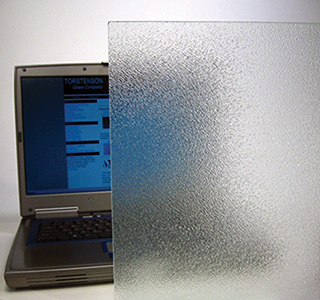
Pattern 62

Single Glue Chip

English Reeded

Acid Etched
FINISHES
A painted finish is suitable for residential and light commercial projects. The finish will withstand exposure to the elements and is resistant to impact. Solar Innovations® offers a wide variety of colors, but will also match any custom color. An anodized finish is best suited for commercial jobs, due to harsher use. Anodized finishes are also designed to withstand the corrosive effects of salt water.
Powder Coat Solids
STANDARD – AAMA 2605§
Black
FRSL 11618
White
FRSL 83247
Sandstone
FRSL 46647
Natural Clay
FRSL 47591
Bronze
FRML 97138
Hartford Green
FRSL 32872
Anodized
Additional cost
Class 1 Clear Anodized
Dark Bronze Anodized
Powder Coat Solids
PREMIUM – AAMA 2605§
Apollo White
FRSL 82908
Bone White
FRSL 82909
Ivory
FRSL 46646
Charcoal
FRSL 74654
Military Light Blue
FRSL 21709
Burgundy
FRSL 62496
Seawolf
FRSL 46645
Fashion Gray
FRSL 74652
Colonial Gray
FRSL 74653
Antique Bronze
FRSL 46648
Metal Clad
STANDARD¶ (EXTERIOR ONLY)
Copper
#4 Polished Stainless Steel
Metal Clad
PREMIUM¶
Rheinzink Bright Rolled‡
Rheinzink Blue Gray‡
Rheinzink Graphite Gray‡
Brass
Bronze
*5 year warranty (finishes available while in stock).
†5 year warranty. Scratch & fade resistant; contains no VOCs. Lead times subject to availability.
§10 year; up to 20 year warranty. Scratch & fade resistant; contains no VOCs. Lead times subject to availability.
¶Lead times subject to availability.
‡Special order.
PLEASE NOTE: Depending upon color selection, additional charges and increased lead times may apply. Extended warranties and service plans are available for an additional charge. Examples are shown as accurate as photography and printing processes allow. Final finish selection should be made from a physical sample; contact Solar Innovations® for samples. Product and finish options are subject to vendor availability. Solar Innovations® reserves the right to discontinue any option at any time without notice. Additional options, including custom color match, are available; contact Solar Innovations® for details.
Metal Cladding
Cladding can be added to the exterior of a greenhouse for aesthetic purposes. Copper and bronze claddings are popular additions to historically-styled greenhouses. Stainless steel cladding is appropriate for a modern greenhouse or coastal applications and will not corrode.

Maintenance
A greenhouse, like any other building, will require maintenance from time to time. The frame and glass will accumulate dust through the seasons, and will need to be removed. Solar Innovations® does not recommend using harsh chemicals. A solution of water, vinegar, and dish detergent will work well to clean the glass and frame. The key is to remove any dirt build-up from the frame, which will prevent future maintenance issues. Operable window and vent tracks need to be cleaned and checked to maintain proper function. Always test your greenhouse accessories, including heating, cooling, shades, operable vents, and windows as a new season approaches. Motorized operations, such as ridge vents, will need occasional lubricating.
GABLE PEDIMENTS

Gable pediments, also referred to as Palladian arches, are added to the triangular gable on a glass structure. The most common designs include a half round arch, with rays extending from the arch. The radius and number of rays are all customized to the structure. Grid work can be used to simulate true pediments or mullions.
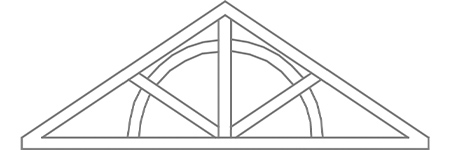
Arched Fan Options 1

Arched Fan Option 2

Arched Fan Option 3

Open Radius

Straight Fan

Traditional Gable
TRANSOMS

Use decorative panel transoms to enhance the appearance of your windows, doors, and wall glass. Transoms are available in two unique styles: etched and gridded. The panel consists of an aluminum shell (which may be painted to match the frame) and a layer of polystyrene insulation. The trim is the same grid material used in the window options.
Gridded
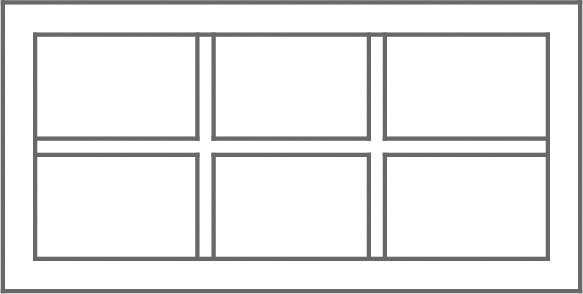
Traditional

Cross

Double Divide

English

Radius
Etched Transoms

Pattern “A”

Pattern “B”

Pattern “C”

Pattern “D”

Pattern “E”

Pattern “F”

Pattern “G”

Pattern “H”

Pattern “I”
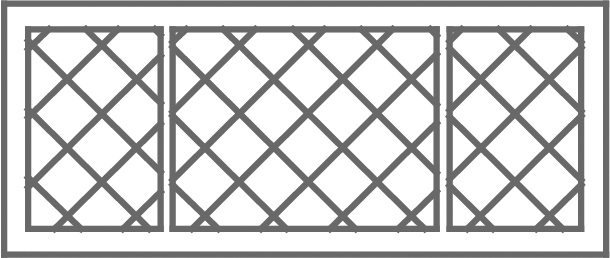
Pattern “J”

Pattern “K”

Pattern “L”
DECORATIVE CORNER POSTS
Decorative corner posts are one of the most classic forms of architecture, and Solar Innovations® can create custom designed columns to fit your structure. The columns can be traditionally modeled, flat, or fluted styled after a Doric or Egyptian column, or for a modern look, contemporary styled.




KNEE WALLS AND BASE PANELS

Knee Walls
Knee walls (base or pony walls) are typically between 30-36 inches tall and are a common feature in greenhouses. Applying a stone or brick veneer to a concrete knee wall is a cost-efficient way to achieve a classic look. Solar Innovations® recommends insulating the knee wall to optimize energy efficiency.

Base Panels
Decorative base panels follow the Elizabethan form of raised grid design. We offer two standard models: a raised panel, featuring an elevated face that protrudes 1/2” from the panel base, and a smooth panel. Base panels add a classic, traditional look to structures and doors.
Base Wall Considerations
Base walls, or knee walls, can be integrated into a structure’s design to meet a desired appearance, but can also provide practical solutions to common problems. In areas where grass needs to be mowed nearby, the base wall will provide protection from mower-thrown projectiles. In areas where snow accumulates, the base wall will provide better thermal protection when snow is piled directly against the structure. Cost savings may also be associated with base walls as it reduces frame height and the glazing area. In all instances, a footed concrete slab should be constructed as the foundation. Solar Innovations® recommends two standard heights, dependent upon how the structure will be used and its surroundings:

Ideal height when furniture is to be positioned against the wall and provides privacy when sitting. In greenhouses, the sun can dry out plant roots on pots on the floor near the walls. This height optimizes that protection. Also, many gardeners store items under perimeter benches. The base wall keeps them out of sight from the exterior.
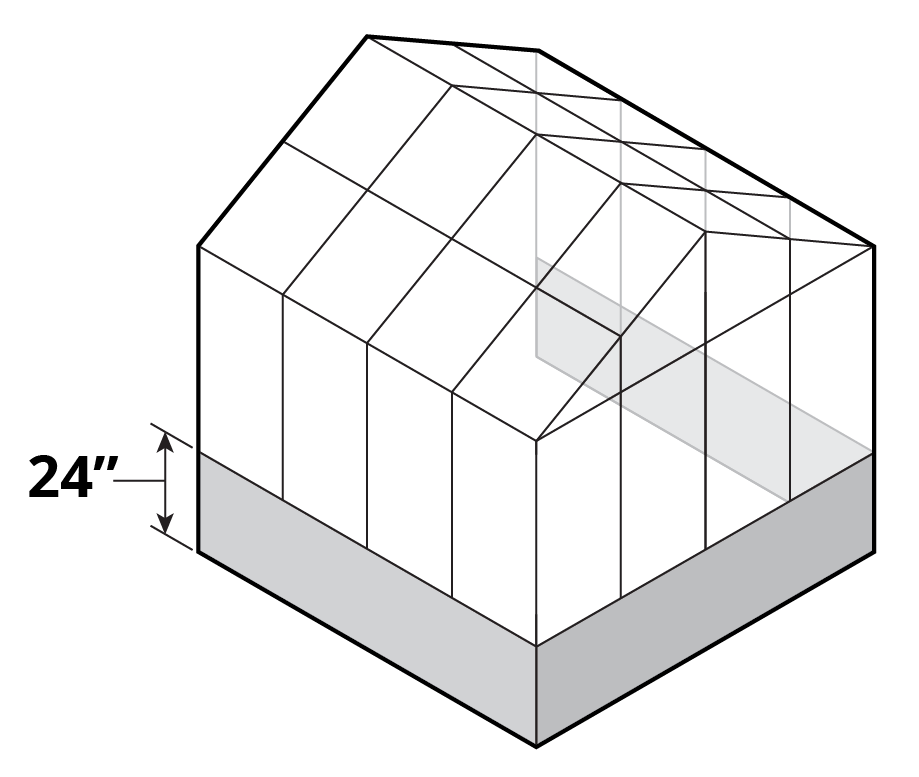
Proper height when no furniture or greenhouse benches are to be positioned against the walls, but still provides some protection against projectiles and snow.

Base walls can be excluded when the maximum amount of daylight is desired and the structure is not in danger of projectiles and snow is not a concern.
WINDOWS
The use of operable windows will help to create cross ventilation and natural air flow, giving you more fresh air to enjoy on beautiful days.


Casement Windows
Casement windows hinge on the left or right and open like a book. They allow for more air circulation than awning windows and can be inswing or outswing.


Pivot Windows
Pivot windows function just like pivot doors and work well when the jamb is not a suitable location to hinge.


Awning Windows
An awning window is the most common type used for ventilation. The window is hinged at the top, cranks out, and can be left open during light rain showers.


Hopper Windows
A hopper window is an operable window typically used above a door or window to ventilate the greenhouse.


Tilt-Turn Windows
A tilt-turn window is a hybrid of a casement and hopper window with a single dual-operation handle.


Fixed Windows
Fixed windows do not operate and are appropriate for areas where the window is difficult to reach.
DOORS
Operable doors are an attractive and functional addition to a greenhouse. Our selection of terrace, French, and pivot doors can be opened so occupants can allow fresh air to enter when the weather is pleasant.


Terrace and French Doors
Terrace doors are single swing doors, while French doors are a set of two swinging doors that operate opposite one another. Units can be hinged left or right and swing in or out. Sizes are custom designed and are constructed of the same materials of the structure.


Pivot Doors
Pivot doors have a similar operation to swing doors but are not hinged at the jamb. The pivot points are located on the head and sill and can be placed anywhere along the width of the door. Multiple pivot doors can be installed directly next to each other.
HARDWARE
Solar Innovations® offers superior quality in our hardware by utilizing stainless steel pins and extruded aluminum hinges to ensure the durability of our products. Solar Innovations® patented recessed bumper handle provides smooth functionality and clean sitelines. Heavy saltwater finishes are available for coastal applications. We also offer a patented adjustable door catch for any of the swing doors in the product line.
Handles: Brass – Inland Applications
Aluminum – Inland Applications

Allegro (Standard)

Capri

Venice

Frankfurt

London


Solid Brass – Coastal Applications

Toronto (Standard)

Rodos

Verona
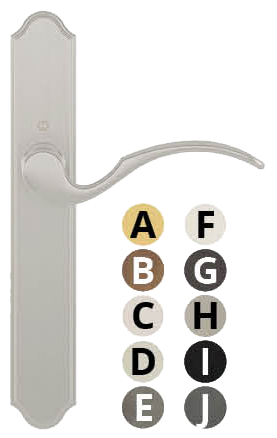
Munchen

Atlanta

Dallas

Contemporary

1005

1035

1058

1076

1102
Closers, Catches, & Limiters
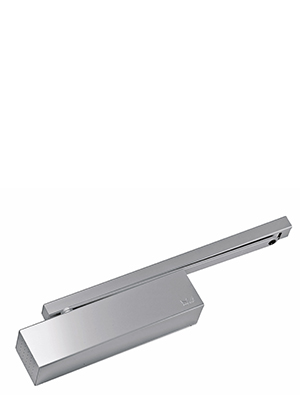
D Series TS93 Door Closer

C Series PR82 Door Closer

Adjustable Door Catch

D Series 7414 Door Closer

Door Limiter
Locks
Hinges

Thumb-Turn Lock

Keyed Lock

Semi-Concealed Hinge Standard

Surface Mount Hinge
Commercial Hardware
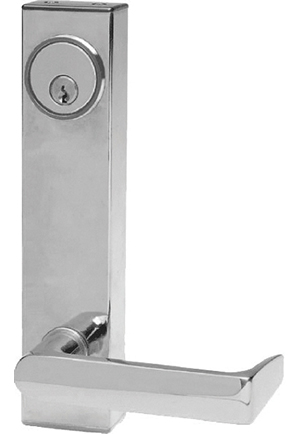
Exterior Entry Trim Square

Mortise Panic

Wire Push/Pull

Square Commercial

Toronto

Wire Push
Please Note: All hardware is subject to vendor availability. Custom finishes may be available upon request at additional lead times an/or cost. Solar Innovations reserves the right to discontinue any hardware option at any time. Please visit solarinnovations.com for additional product information.
RIDGE VENTS
Thermally enhanced aluminum ridge vents provide natural ventilation to promote plant growth in glazed structures. Ridge vents work in tandem with eave vents, creating a circulation pattern by bringing cooler air into the structure through the eave vents while the warmer air escapes through the ridge vents. This circulation will make the structure more comfortable and help reduce the spread of diseases in plants. Vents can be set to automatically open when a specified temperature is reached or close when rain or snow is detected.
Features
- Thermally enhanced aluminum profile
- Glazing infills from 3⁄16” to 1”
- Accommodates any glazing option including glass, polycarbonate, acrylic, insulated metal panels
- Fixed mesh insect screen
- Standard height 27”
- Multiple bays connected together
- Manual operation with a pole operator
Options
- Rain sensors
- Wireless remote control
- Thermostatic control
- Motorized operation
- Oversized units upon request
Motorized Features
- Temperature based automated operation
- Water resistant motors
- With a weather station or sensor, vents close when rain or snow is detected
- Timed & grouped operation of multiple vents
EAVE VENTS
Thermally enhanced aluminum eave vents provide natural ventilation to promote plant growth in glazed structures. Eave vents work in tandem with ridge vents, creating a circulation pattern by bringing cooler air into the structure through the eave vents while the warmer air escapes through the ridge vents. This circulation will make the structure more comfortable and help reduce the spread of diseases in plants. Vents can be set to automatically open when a specified temperature is reached or close when rain or snow is detected.
Features
- Thermally enhanced aluminum profile
- Glazing infills from 3⁄16” to 1”
- Accommodates any glazing option including glass, polycarbonate, acrylic, insulated metal panels
- Fixed mesh insect screen
- Standard height 27”
- Multiple bays connected together
- Manual operation with a pole operator
Options
- Rain sensors
- Wireless remote control
- Thermostatic control
- Motorized operation
- Oversized units upon request
Motorized Features
- Temperature based automated operation
- Water resistant motors
- With a weather station or sensor, vents close when rain or snow is detected
- Timed & grouped operation of multiple vents
GUTTERS AND DOWNSPOUTS
Gutters and downspouts are a functional necessity to any structure yet they need not be an eyesore; they can be aesthetically appealing and double as an architectural element. Gutters are available in several styles and finishes, including traditional copper, and include downspouts in standard, round, or fluted round shapes. We specialize in restoration projects and can provide custom cast aluminum elbows, drop outs, and extruded downspouts to mimic an existing structure’s architecture.


Box

Greenhouse

Decorative

Restoration



CAST ALUMINUM ELBOW
21/2 INCH DOWNSPOUT
GRIDS
Decorative grids enhance the look of any structure, and are available in five standard types: low profile, ogee, colonial, traditional, and large-traditional. They can be formed into almost any grid style, including radius designs. Grids can be applied three ways: as interior muntins, exterior grids and Simulated Divided Lites (SDLs). Interior muntins are placed inside the airspace between two panes of glass and are typically more cost effective and easier to clean than exterior grids and SDLs. Exterior grids are placed on the interior and exterior of the window and work well with single pane glass but have drawbacks on insulated glass, as you can easily tell it is not a true divided lite because, at an angle, you can see the lack of structure between the glass panes. The solution to this is an SDL which provides an encapsulated bar within the glass, giving a better illusion of a true divided lite.

Grid Types (For windows, transoms and base panels)


Traditional
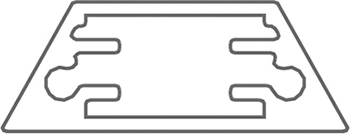
Wide Traditional

Colonial

Low Profile

Ogee

Steel Look
Grid Patterns

Traditional

Arched

Cross

Double Gothic

English

Gothic
Grid Applications

Interior Muntin

Exterior Grid (Single pane)

Exterior Grid (Insulated)

Simulated Divided Lite (SDL)
MOLDING AND TRIM
Solar Innovations® offers extruded decorative trims in durable aluminum, which will not warp, rot, rust, or require finish maintenance like traditional wooden trim. All trims are suitable for interior and exterior use.

Horizontal Molding

Bulbous
Crown
Cyma
Cyma Reversa
Large Bulbous
Vertical Molding

Beveled
Flat
1″ Flat
Concave
Ogee
Sunken Fillet
FINIALS
A finial, also known as a spire, is typically located at the highest peak of a structure’s roof. Dormers, lanterns, ridges, and entryways can all utilize finials. Some finials can also be used as lightning rods when properly sized, designed, and installed.

7″ Fleur De Lis

7″ Fleur De Lis with Curve

6 3⁄8″ Fleur De Lis

6 3⁄4″ Fleur De Lis

7 1⁄2″ Spire

10 3⁄4″ Spire

4 3⁄16″ Ball

Bell Cap

16″ Ball & Spire

15 1⁄2″ Ball & Spire

27″ Ball & Spire

21″ Ball & Spire

20 1⁄4″ Double Ball & Spire

25 1⁄2″ Double Ball & Spire
KING POSTS
King posts act as the base for finials that attach above and below. They are typically placed at the end of a structure’s ridge cresting to create a dramatic decorative finale to the roof line.
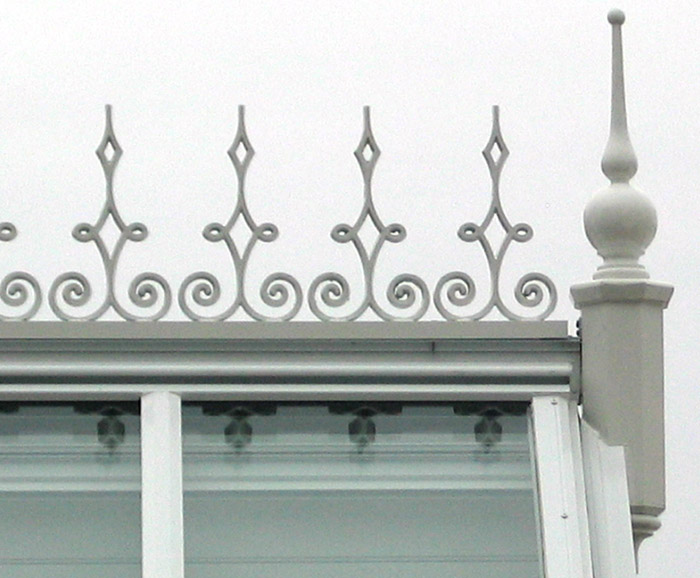
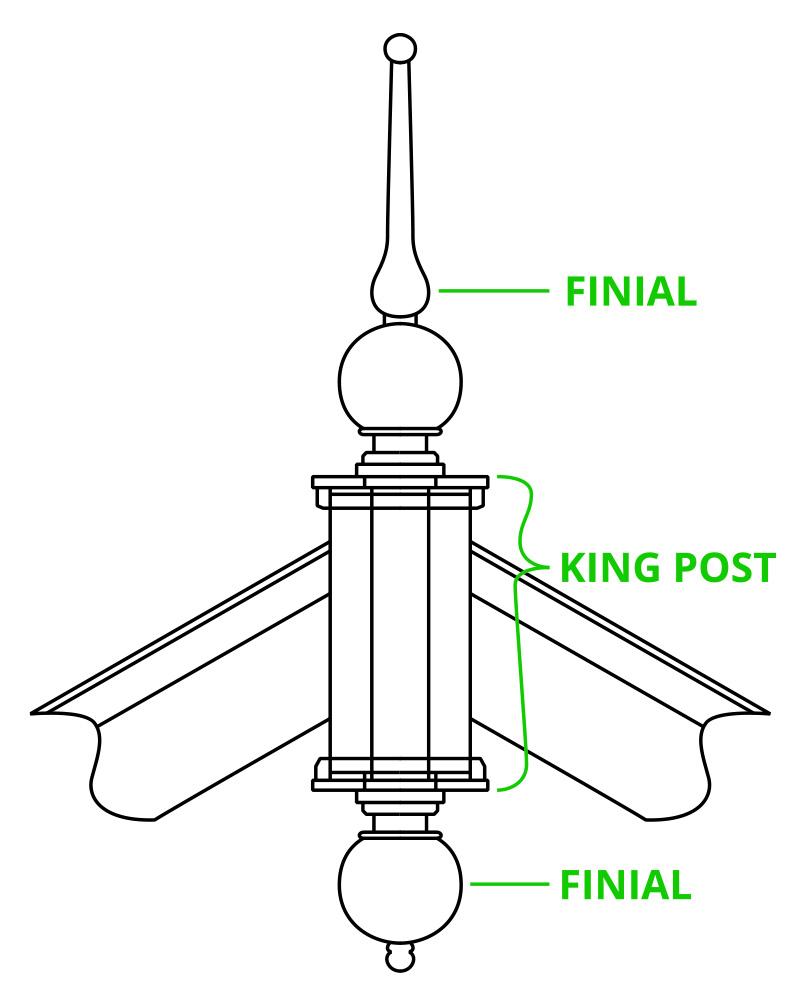
RIDGE CRESTING
Ridge cresting is used to enhance the ridge line of a glass structure, especially in Classic English designs. Several styles of ridge cresting are available. A finial and king post is typically used to terminate the ridge cresting’s length.

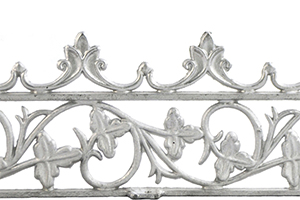
Ivy
CA66

Spire
CA59

Fleur De Lis
CA54

Gated
CA75
RING AND COLLAR TIES
The ring and collar tie serves as a structural brace and cross tie for larger structures or free standing structures. Decorative appliqués can be added to each side of the ring for additional interest.

Appliqué

Fleur De Lis
CA76

Round
CA35

Flower
CA28

Fleur De Lis
CA27

Flower
CA23
APPLIQUES
Decorative appliqués are elements that can add character to structures. Each cast aluminum appliqué features one of two main motifs: the rosette or the Fleur de lis.

FLEUR DE LIS
CA76

ROUND
CA35

FLOWER
CA28

FLEUR DE LIS
CA27

FLOWER
CA23
DECORATIVE CORNERS
Decorative corners, or eave spandrels, can be found in buildings as early as ancient Rome. An eave spandrel was historically the space between an arch and a wall or column, but can also occupy the space between a wall and a squared-off opening. While eave spandrels are primarily decorative, they can also be used for shelf supports or plant hangers.


SCREENS
Screen swing doors are available for both terrace and French doors. The screen swing door is constructed from an aluminum frame that mimics the sitelines of our glazed swing doors. Screens are also often incorporated into our eave and ridge vents.

MAINTENANCE AND SERVICE
Maintenance
A greenhouse, like any other structure, will require regular maintenance. The frame and glass will accumulate dirt, which will need to be removed, preventing future maintenance issues. Solar Innovations® does not recommend using harsh chemicals, a simple solution of water, vinegar and dish detergent will work well to clean the frame and glass. Operable window and vent tracks need to be cleaned and checked regularly to maintain proper function. Always test your greenhouse accessories as a new season approaches. Motorized operations, such as ridge vents, will need occasional lubrication. Leaves and debris will also need to be removed from gutters.
Repair & Replacement Services
Our products are backed by an industry-leading warranty. In the event of a problem, our team has the technical skill and experience to evaluate your situation and determine the most effective options for repair, service, or replacement of your product. All drawings and information are saved for each project, so a preliminary site visit isn’t always required.

BENCHES/POTTING BENCHES
Benches are not only an essential component to any greenhouse but also can be designed to meet the needs of a wide variety of growers. Solar Innovations® can build benches that best match the demands of each individual greenhouse. Here are just a few examples:

Master Gardener Potting Bench
Potting benches are used as workstations to pot flowers, store tools, and prune plants. A sink can be incorporated to enhance its functionality.

Fixed
Fixed benches are a staple in greenhouses. They have aluminum bases and are available with mahogany, galvanized steel mesh, or black polyethylene crosshatched tops.

Seedling
Seedling benches are raised beds on legs which allow you to grow plants directly in the soil. The bench has a solid bottom and can be designed to accommodate varying soil depths.

Rolling
Rolling benches have fixed legs and a movable top, allowing for the workspace to shift from aisle to aisle, freeing up valuable space in the greenhouse.

Tiered
Tiered benches can stand up to three levels tall and can be placed above the bench to expand space or under the bench for low-light plants.

Gravel
Gravel benches consist of a solid bench top, which is filled with gravel and water. This is an ideal bench for humidity-loving plants such as tropicals and orchids.
COLD GROWING FRAMES
Cold Frames are one of the oldest forms of greenhouses. They are essentially a glass box with aluminum framing and a lid. Their main function is to extend the growing season into early spring and late fall. They are placed directly above where plants will be grown. During the night and cold days, the lid is kept closed to retain heat. Then, when the days are warm, the lid is opened to allow for fresh air.
Cold Frames are historically constructed out of wood, which is subject to rotting after a few years and will require frequent maintenance. Solar Innovations®’s Cold Frames are constructed out of aluminum, which will not rot, warp, or rust. Each unit is custom designed to your specifications; you may choose as many bays as needed and are available in all of our standard colors. They can also be modified to be heated from greenhouse ventilation if desired.

ENVIRONMENTAL CONTROL SYSTEMS
A fully functioning greenhouse often has many systems. They include watering, lighting, heating, ventilation, and various others. Plants will flourish if humidity, temperature, and air circulation are precisely controlled. Solar Innovations® recommends an environmental control system that can automate each accessory’s operation, easing the burden of maintenance.
For the environmental control system to function automatically, data is collected from sensors positioned inside the greenhouse and from a weather station attached outside. The system monitors the data and controls the operation of accessories from predetermined settings. The ridge vents and windows will automatically open when the greenhouse becomes too hot. The evaporative cooler will start to operate if a desirable temperature is not reached. The same is true for heating and watering systems. Accessories can be grouped together or operated independently. For example, two ridge vents can be programmed to open simultaneously or independently. A staged opening allows ventilation units to open at varying degrees between the fully open and fully closed positions.
Advanced Technology
Software can be installed on your computer to control the greenhouse’s settings. Daily records can be created and saved for future reference. The software is capable of setting off alarms if the temperature falls out of range, and can even send an alert to your cell phone.
Controllable Accessories
- Ridge Vents
- Eave Vents
- Motorized Windows
- Heaters
- Cooling Systems
- Circulation Fans
- Grow Lights
- Misting Systems
- Watering Systems
- Shade Systems
| Volts | Amps |
|---|---|
| 120 | NA |

Control Panel

Greenhouse Sensors

Weather Station
EVAPORATIVE COOLERS
A greenhouse has the potential to get too hot in the summer, even with ventilation. In order to preserve the plants, cooling needs to be incorporated. Solar Innovations® recommends an Evaporative Cooler which reduces temperature and adds humidity to the greenhouse.
The Evaporative Cooler draws air over a wet pad, by way of a fan. As the water passes over the pads, it evaporates and takes heat with it. The air then passes into the greenhouse and can be up to 30° cooler. Evaporative Coolers consume ¼ less energy than traditional air conditioners. Evaporative Coolers exchange air; rather than re-circulating stagnant air; a benefit for greenhouses which need fresh air to combat pests and disease.
Portable Evaporative Coolers
Portable evaporative coolers provide a low-cost, environmentally-friendly means of keeping spaces cool. Water and forced air are combined to reduce air temperatures by as much as 26°F. These coolers have a computer-programmed control panel with LCD display, and come with a convenient remote control.

| Model | Dimensions (H x W) | Draft Direction | CFMs | HP | Weight (lbs) | Volts | Amps |
|---|---|---|---|---|---|---|---|
| 300SD | 33 7⁄16″ | Side Draft | 3,000 | 1/3 | 193 | 115 | 7.2 |
| N30S | 33 7⁄16″ x 28 1⁄2″ | Side Draft | 2,077 | 1/3 | 193 | 115 | NA |
| N40/45S | 34 1⁄2″ x 34 1⁄2″ | Side Draft | 4,000-4,800 | 1/3 or 1/2 | 269 | 115 | NA |
| N55/65 | 42 7⁄16″ x 39″ | Side Draft | 5,000-6,000 | 1/2 or 3/4 | 357 | 115 | NA |
| 30″ Portable | 59″ x 44″ | Front | 10,500 | 3/4 | 110 | 115 | NA |
FANS
Circulation Fans
Circulation Fans eliminates stagnant air, which breeds diseases, while also reducing the spread of fungi and pests. Moist leaves combined with warm temperatures will promote disease growth. They help dry plants quicker and reduce pests. A Circulation Fan can also help eliminate pockets of hot and cold air in a greenhouse. Two fans are typically used in a greenhouse and placed in opposite corners.
Features
- Fully enclosed motors
- Hanging mount
- Framework built for greenhouses & high moisture environments
- Optional variable speed controllers
- White frame

Circulation Fan Models
| Model | Diameter | Performance | Weight (lbs.) | Volts | Amps |
|---|---|---|---|---|---|
| VK8 | 8″ | 448 CFM* | 8 | 115 | 0.6 |
| VK12 | 12″ | 1,554 CFM | 18 | 115/230 | 1.3/0.65 |
| VK20 | 20″ | 4,000-4,800 CFM | 37 | 115/230 | 3.8/1.9 |
| VK24 | 24″ | 5,000-6,000 CFM | 46 | 115/230 | 4.8/2.4 |
| SI Dram | 24″ | 5,000-6,000 CFM | NA | NA | NA |
*Cubic feet per minute

Exhaust Fans
Exhaust fans pull hot air out of a structure and prevent it from becoming trapped at the ridge. They help circulate air within a structure and maintain a constant temperature.
Features
- Triggered by temperature
- Best suited for monolithic glazed greenhouses
- PVC shell with aluminum blades
- Motorized operation
- Lower intakes pull cool air into the greenhouse
- Placed opposite exhaust fan
- Shutter must be 6″ larger than the fan
Available Models
| Model | HP | RPM | Diameter | Performance | Motorized intake | Weight (lbs.) | Volts | Amps |
|---|---|---|---|---|---|---|---|---|
| SFT-1200-1 | 1/30 | 1,550 | 12″ | 760 CFM* | MIT-1600 16″ | 12 | 115 | 0.9 |
| SFT-1600-1 | 1/10 | 1,725 | 16″ | 1,250 CFM | MIT-2000 20″ | 21 | 115/230 | 1.3/0.65 |
| SFT-2000-1 | 1/3 | 1,725 | 20″ | 3,122 CFM | MIT-2200 22″ | 31 | 115/230 | 3.8/1.9 |
*Cubic feet per minute
FERTILIZER INJECTORS
Fertilizer injectors are the most efficient way to feed plants by delivering liquid nutrients directly into the water supply line. They are a fast and accurate way to feed an entire garden, landscape, nursery or greenhouse.
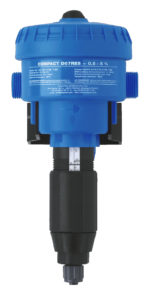
LIGHTING
The amount of hours a plant grows can be extended with supplemental lighting known as grow lights. Most year-round greenhouses will require lighting during the winter so plants receive the necessary photoperiod for normal development. Grow lights can be used to produce artificial sunlight on shady days when plants do not receive sufficient sunlight. Plants can produce more flowers or fruit in a shorter amount of time with this additional lighting.


High-Efficiency LED Light
Durable and energy efficient, an LED grow light provides uniform lighting and is designed to improve yield. These grow lamps are fully programmable and use 40 percent less energy than High Pressure Sodium lights. They are also easy to install and you never need to replace bulbs.
| Volts | Amps |
|---|---|
| 120/240 | 3.3/1.65 |

High-Pressure Sodium Light
A high-pressure sodium light emits more light in the red/orange wavelengths to promote greater flowers and fruit. It is recommended for production of vegetables and cut flowers. Using this light constantly, even during daylight, can provide increased production.
| Volts | Amps |
|---|---|
| 120 | NA |

Metal Halide Light
A metal halide grow light emits more light in the blue wavelength spectrum to promote vegetative plant growth. Plants grown under this type of light are typically taller and bushier.

Workspace Lighting
Most lights are not designed to withstand the amount of water and humidity in greenhouses. Lights will eventually rust, break, or stop functioning. Water-resistant systems with fluorescent lights can be mounted at the ridge of a structure for illumination.
HEAT MATS
Heat mats help gardeners have better success rates with seedlings and cuttings. They warm root areas approximately 10–20° F over ambient temperature to improve germination process. Perfect for one standard 10 in x 20 in propagation tray, allowing for even warming of the entire tray.
HEATERS
The interior temperature of a greenhouse is critical to how well your plants grow. All glass structures are prone to solar heat gain, meaning the sun’s rays generate heat, which is trapped inside the glass structure — think of getting in your car after it has been sitting in a sunny parking space all day. But during the winter, the sun can’t do all the work; most greenhouses will need to be heated to provide the proper indoor environment for plants. Some tropical plants require the greenhouse be kept at a constant, warm temperature, while hardy cold crops such as lettuce and kale thrive at lower temperatures.
Heating Systems
Several sources can be used to produce heat, including: electric, propane, natural gas, oil, radiant, wood, and solar thermal. These heating systems have different advantages. Several factors, including greenhouse size, location, use and glass-type, determine what size heater, or number of heaters are required.
Our greenhouse experts evaluate your needs to provide the best heating solution, including the proper fuel source.
Solar Innovations® offers four styles of heaters, including floor mounted and roof-hung units, where vents are placed in the walls, electric roof-hung units that are vent-less, and a wall mounted, direct vent version. All heaters run efficiently through thermostatic temperature controls and a matchless ignition.
Hydronic Heating
Hydronic heat is a clean, healthy, and energy efficient method of heating a glass structure. The motor of a hydronic heater does not blow air through vents where dust resides, resulting in a cleaner system. These motors are also quieter than those found in traditional heating systems. An added benefit of a hydronic heater is it is energy efficient, reducing utility bills.
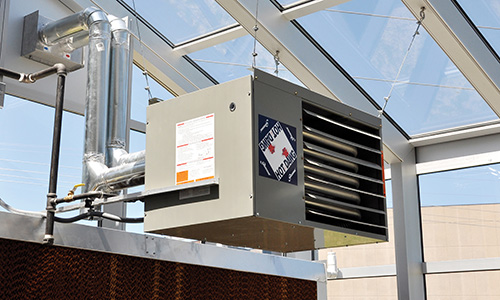
Interior Mount Gas Heater

Interior Mount Electric Heater

Exterior Mount Heating Unit

For large greenhouses Solar Innovations® recommends an exterior mount heater with a louvered vent mounted opposite the heater.
| Manufacturer | Model | BTU output | Dimensions (LxHxD) |
Entering Airflow (CFM) |
Heat Throw (ft) at Max Height |
Volts | Amps | Fuel |
|---|---|---|---|---|---|---|---|---|
| Modine Hot Dawg | HD30 | 24,000 | 263/4” x 121/4” x 22″ | 505 | 25 | 115 | 3.7 | Gas |
| Modine Hot Dawg | HD45 | 36,000 | 263/4” x 121/4” x 22″ | 720 | 27 | 115 | 3.7 | Gas |
| Modine Hot Dawg | HD60 | 48,000 | 263/4” x 18″ x 25″ | 990 | 36 | 115 | 2.5 | Gas |
| Modine Hot Dawg | HD75 | 60,000 | 263/4” x 18″ x 25″ | 1,160 | 38 | 115 | 2.5 | Gas |
| Modine Hot Dawg | HD100 | 80,000 | 351/2” x 201/2” x 31″ | 1,490 | 42 | 115 | 4.7 | Gas |
| Modine Hot Dawg | HD125 | 100,000 | 351/2” x 201/2” x 31″ | 1,490 | 42 | 115 | 4.2 | Gas |
| Modine Electric | HER50C3101 | 17,100 | 141/4” x 171/2” x 121/4“ | 380 | 12 | 208V 3 Phase | 24.5 | Electric |
| Empire | DV20E | 20,000 | 37″ x 26″ x 153/4“ | 350 | 25 | 115 | 5 | Gas |
| Empire | DV40E | 40,000 | 37″ x 26″ x 153/4“ | 350 | 35 | 115 | 5 | Gas |
| Empire | DV55E | 55,000 | 37″ x 26″ x 153/4“ | 400 | 50 | 115 | 5 | Gas |
| Markel Electric | 492296 | 25,000 | NA | 375 | 25 | NA | NA | Electric |
| Markel Electric | 492290 | 11,200 | NA | 375 | 20 | NA | NA | Electric |
HOSE REELS
A retractable hose reel makes a greenhouse a less cluttered and safer environment. An adjustable return control system eliminates the dangerous whipping action found in other brands. This reel has several mounting configurations.

HUMIDIFIERS/FOGGERS
Humidifiers, or foggers, are utilized to control moisture levels in the air for optimal plant growth. When humidity drops below a predetermined level, a sensor triggers the humidifier to activate, blowing a fine mist throughout the space. For more advanced applications, high pressure foggers and oscillators are available.

Turbo XE 500 & XE 1000
- Used on mid-sized greenhouses; Models available for larger greenhouses
- XE 500 propels water up to 25′
- XE 1000 propels water up to 30′
- Quiet & noise free operation
- Withstands salt, lime, & acid exposure
- Withstands 100% relative humidity
- No filters or special pumps required

Hydro SS 700
- Used on smaller greenhouses
- Direct feed hanging units receive liquid through a visual flow meter control panel
- Equipped with a 5 GPH flow meter panel & 12′ condensation drainage line
- Propels water up to 20′
- No filters or special pumps required
- All hardware is stainless steel
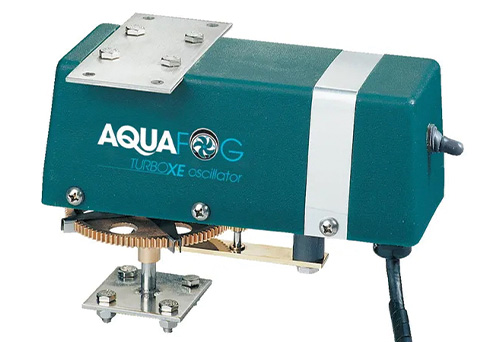
Oscillator
| Model | Misting (gallons per hour) | HP | CFM | Dimensions (width x height) | Weight (lbs.) | Volts | Amps |
|---|---|---|---|---|---|---|---|
| Turbo XE500 | 11 GPH | 1/2 | 2,160 | 17 1⁄2″ width x 22 1⁄2″ height | 46 | 115/230 | 7.4 |
| Turbo XE1000 | 24 GPH | 1/2 | 2,730 | 17 1⁄2″ width x 22 1⁄2″ height | 46 | 115/230 | 7.4 |
| Hydro SS700 | Up to 3.5 GPH | NA | 980 | 15″ width x 12″ depth | 10 | 115 | 1.5 |
| Turbo Oscillator | NA | NA | NA | 9 3⁄4″ L x 6 1⁄4″ H x 4″ W | NA | 115/230 | NA |
IRRIGATION SYSTEMS

PLANT HANGERS
A variety of plants can be grown year-round in hanging baskets within the greenhouse. Solar Innovations® offers a variety of hangers.
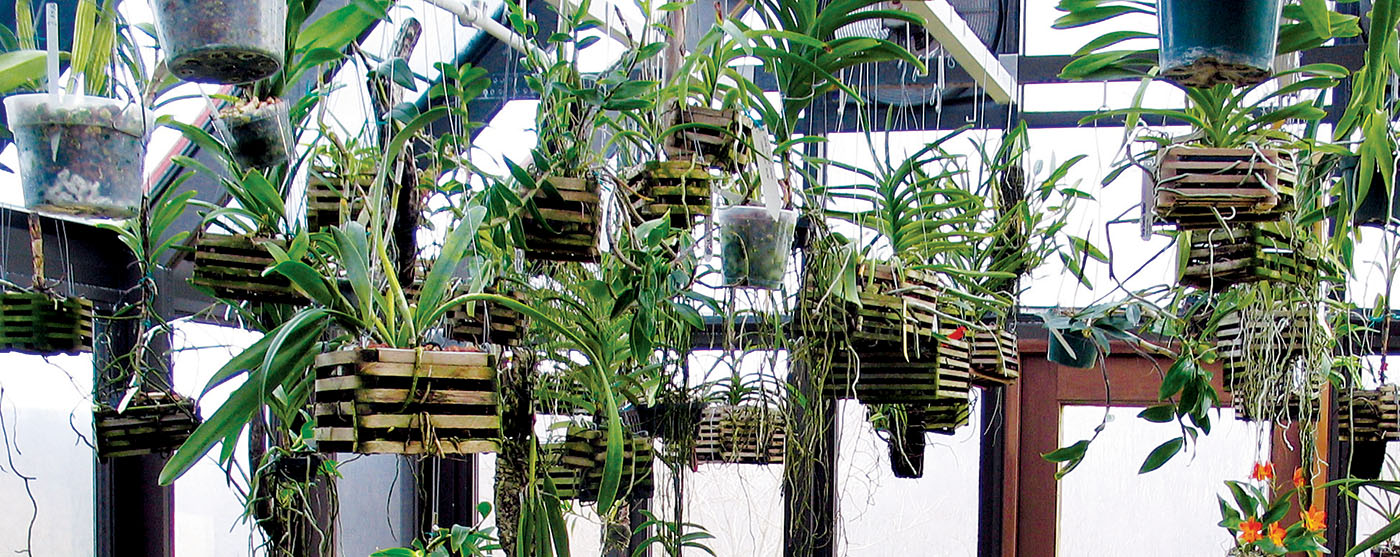
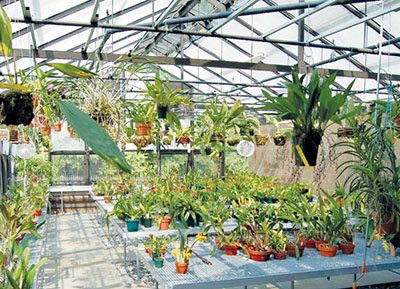
Truss
A truss is a structural element that spans the width of the greenhouse and, with the proper design, can hold a high quantity of heavy plants.

Ring and Collar Ties
Ring and collars ties are a type of historical plant hanger and are attached to the structure. They can be adorned with an appliqué and hold medium weight plants in large quantities.

Aluminum Pipe Hangers
Aluminum pipe plant hangers are stationary tubes that can hold a large amount of medium to lightweight plants.

Single Rafter Hangers
Individual o-hooks are inserted into the rafter. Each hook holds one hanging basket.

Sliding Hangers
A sliding plant hanger is designed with wheels built into the unit that make a plant’s relocation effortless.
SHADES AND BLINDS
The summer sun may be too intense for some plants, causing them to burn or die. One way to avoid this situation is to install a shading system. Solar Innovations® provides operable, fixed, interior, and exterior shading systems. Most of our shades and blinds are designed for high-moisture areas and are water, bacteria, and fungi resistant. Fixed shades permanently attach to the frame and are appropriate for greenhouses that are used to grow delicate plants such as orchids or other tropical flowers that may be sensitive to overexposure. Operable shades allow you to control the amount of light entering the greenhouse and are available in manual or motorized options.
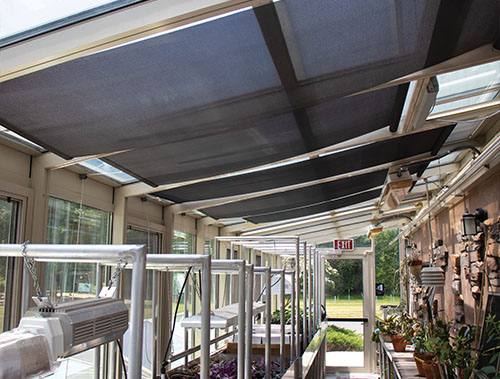
Manual Roller Shades

Wide-Span Shades

Exterior Shades

Fixed Shades

Gravity-Fed Shades
SHELVES
Shelving is a great way to expand your greenhouse’s growing area. The units can be placed directly in front of a window, on a solid wall, or located high on the eaves and come in a variety of styles.

Open Grate
Open grate shelves allow for optimal air flow and ease of maintenance and are available in galvanized steel or polyethylene plastic tops.
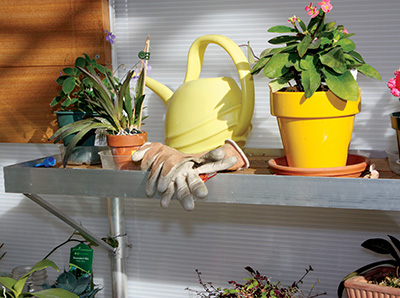
Adjustable Metal Bracket
Metal bracket shelving supports are an economical choice, have a functional appearance, and can be mounted above or below the shelf.

Decorative Casting Bracket
Decorative corner shelf supports work well with conservatory-style greenhouses and can double as a plant hanger.
SINKS
Your greenhouse will be much more functional with the addition of a sink which can stand alone or be incorporated into one of our benches.

TRELLISES
Aluminum trellises are available in single or stacked configurations. Trellises can be as tall as needed and are appropriate for interior and exterior gardens.

Single Trellis

Stacked Trellis
ACCESSORY PACKAGES
Choosing the right greenhouse accessories can be a challenge for even the seasoned grower. The Solar Innovations® sales designers tailored the following packages to set you on the right path toward a successful greenhouse.

Palms
- Circulation Fans
- Heater
- Evaporative Cooler
- Humidifier
- Drip System
- Retractable Hose Reel
- Shades
- Control System

Tropical
- Circulation Fans
- Heater
- Evaporative Cooler
- Humidifier
- Fixed Benches
- Retractable Hose Reel
- Sliding Plant Hanger
- Grow Lights
- Trellis
- Control System
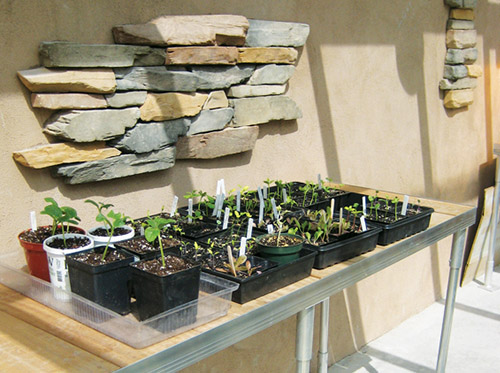
Beginner Greenhouse
- Circulating Fans
- Heater
- Evaporative Cooler
- Standard Benches
- Thermostats

Year-Round House Plants
- Circulation Fans
- Heater
- Evaporative Cooler
- Fixed Benches
- Potting Benches
- Retractable Hose Reel
- Sliding Plant Hanger
- Shelves
- Fixed Shades
- Thermostats

Seeds/Propagate/Vegetables
- Circulation Fans
- Heater
- Evaporative Cooler
- Fixed Benches
- Potting Benches
- Raised Seedling Benches
- Retractable Hose Reel
- Grow Lights
- Trellis
- Heat Mats
- Thermostats

Orchids
- Circulation Fans
- Heater
- Evaporative Cooler
- Humidifier
- Fixed Benches
- Gravel Benches
- Drip System
- Retractable Hose Reel
- Fixed Tube Plant Hanger
- Control System


